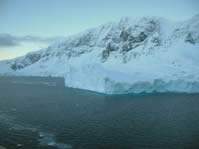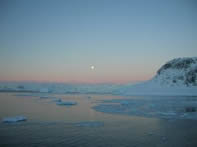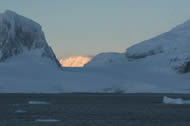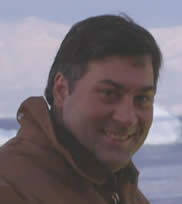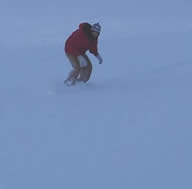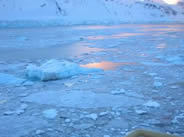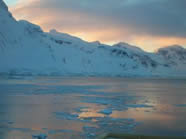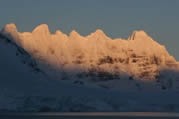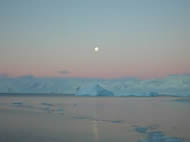
 |
| Academic Departments | Student Services | Alumni | Research | Outreach | Diversity |
| 1 | 2 | 3 | 4 | 5 | 6 | |
| 7 | 8 | 9 | 10 | 11 | 12 | 13 |
| 14 | 15 | 16 | 17 | 18 | 19 | 20 |
| 21 | 22 | 23 | 24 | 25 | 26 | 27 |
| 28 | 29 | 30 | 31 |
| 1 | 2 | 3 | ||||
| 4 | 5 | 6 | 7 | 8 | 9 | 10 |
| 11 | 12 | 13 | 14 | 15 | 16 | 17 |
| 18 | 19 | 20 | 21 | 22 | 23 | 24 |
| 25 | 26 | 27 | 28 | 29 | 30 |
Daily Journals
June 9, 2006 - Neumayer Strait and Gerlache Channel
We hit the lottery again on this glorious day for navigating the beautiful waters and scenery of the Neumayer Strait on our way to the Gerlache Channel. The Neumayer is fjord-like in its being a narrow channel with the landmass rising nearly straight up on either side. The high walls with their ice and snow are breathtaking. Everyone was out on deck taking advantage of the light and sights allowed us in these most fortunate passage conditions. You would appreciate the character and beauty of each peak and glacier, both glare dark brown rock and blue, blue ice in every frame. “Stark beauty” personified. The channel was also strewn with icebergs of every imaginable shape. They didn’t create much of a problem for navigating today, as the water is deep throughout and the mate could ‘snake’ around them. I noticed what I thought was a trapped cloud at the water line in the hollow of one cliff, but was told it was probably the remnants of a recent avalanche an avalanche that fell straight down. Sure enough, the cloud traveled up the cliff a short way, then dissipated. I wished I’d seen that snow fall! The Bridge was very busy with people and cameras the entire length of the passage. It was very cold out, so some of us would step out and take a few photos and come back in. Others were bundled up for serious sightseeing and cruised the 02 deck (one down from the Bridge, but goes all around the ship) for the best vantages and most glorious shots. When it was quiet, you could hear the music playing softly over the speakers. I heard Vivaldi and Mozart while slowly steaming through this stunning hall of ageless ice and even older rock against a sunset sky. Just when you thought it couldn’t be any more breathtaking, the moon rose on the eastern side in the perfect bend of rock that cupped it as though lifting it into the sky. In the southern end of the passage, Ken Halanych captured a shot of an abandoned UK station. See the contrast in size between that station in the foreground bottom, and the landscape behind it.
Getting To Know You Dr. Ken Halanych Ken Halanych, the Chief Scientist of the cruise, is an Associate Professor from Auburn University where he coordinates the Marine Biology program. Together, he and Rudy Scheltema are the principle investigators on the National Science Foundation’s Office of Polar Program grant that is sponsoring this work. Ken got involved in the Antarctic work when Rudy invited him to join the 2000 cruise. Ken became interested in many of the same questions that Rudy was already exploring. However, because of his background exploring evolution in marine invertebrates with molecular tools, he approached the questions from a different angle. Instead of looking for the physical presence of larvae in the water column, he decided to use DNA to determine if benthic adult organisms in South America and Antarctica had common or separate evolutionary histories. These DNA techniques also have the ability to match larva with the adult forms; the life history of most of these animals is poorly known in that we do not know which larvae go with which adults. As the Chief Scientist of the cruise, Ken has to organize and schedule the scientific activities on the boat. By working closely with the Captain of the Ship (Marty Galster) and the Raytheon Main Point of Contact (MPC, Jon Alberts), Ken basically gets to decide where the boat goes and how much time we will spend doing science there. Part of this decision process is to try and make sure that everyone gets the data or organism they need to test their hypotheses. Much of the Chief Scientist’s work started more than 6 months before the cruise. Working with Raytheon, Rudi Scheltema, Izzie Williams, and the other scientists on the boat, Ken had to make sure we had the necessary supplies for our work (no small task as the nearest 7-11 convenience store is at least 10,000 miles away). He also had to work with the medical and travel departments of Raytheon to make sure everyone was physically fit, and had travel arrangements to and from the ship. There was also the step of applying for permits plus there will be the required reports for having performed work in waters off Argentina and the Falklands.
Back to the Science Up to now, 60 Science Stations have been performed. Congratulations to the science teams! We didn’t perform any new science today, but a couple of science projects being done by scientists here in conjunction with this cruise, had some problems that may influence their outcomes because the ideal environments for their experiments changed. There are several details to be concerned with when working in a changeable environment such as a ship, and risks one takes when working outside of their own home lab. The documentation these people kept along the way may be the thing that saves the data and proof of their work, so that it is not all for naught. In any event, some important work has been done here, that will likely end up in print as innovative, exciting, and new. Ken has put a signup sheet for people aboard to give talks during our long passage through the Drake waters. I’ll summarize those as they come to pass. Slide Show June 9th [Insert Photo 6] [Insert Photo 7] [Insert Photo 8] [Insert Photo 9] [Insert Photo 10]
Don't hesitate to email questions to us at outreach@lmg.usap.gov
|
Longitude/Latitude: S64° 50.442’ W63° 56.152’ Temperature: Wind: SE 29-32kn Wind Chill: -21.1°C
Menu: Pork roast with sauerkraut, Shepherd’s pie, vegs. I don’t know I missed lunch; Fried fish, fried calamari, French fries, sweet/sour pork, rice, soup, salad, cinnamon buns, choc pudding, ice cream, and cookies
Photos:Iceberg in Neumayer Strait. [Photo by Ellen Bailey]
Moonrise over Neumayer Strait. [Photo by Ellen Bailey]
Port Lockery Station in Neumayer Strait. [Photo by Ken Halanych]
Dr. Ken Halanych [Photo by Andy Mahon]
Jonathan Craft takes a snowboard ride down the glacier at Palmer Station. [Photo by Janis Umschlag]
True colors the Sunset sky reflects in the waters of the Neumayer Strait. [Photo by Ellen Bailey]
The sun we never really saw today, is setting behind these peaks. [Photo by Ellen Bailey]
“The Seven Sisters” of Anvers Island (home to Palmer Station). [Photo by Ellen Bailey]
Moon over clouds over mountains over icebergs over smooth Neumayer waters. [Photo by Ellen Bailey] |
- Alabama Agricultural Experiment Station
- Alabama Cooperative Extension System
- Auburn Online Community
- Bookstore
- Center for Diversity
- Crisis/Incident Assistance
- Diversity and Multicultural Affairs
- Financial Aid
- Hotel and Conference Center
- Jule Collins Smith Museum of Fine Art
- Medical Clinic
- Southeastern Raptor Center
- Special Reports
- Students w/ Disabilities
- Theatre
